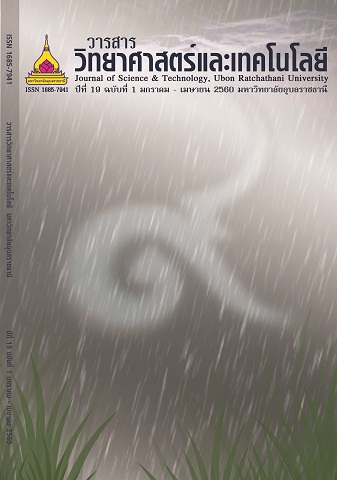การเปรียบเทียบการเจริญเติบโตและผลผลิตบัวบก (Centella asiatica (L.) Urb.) ที่ปลูกโดยใช้ปุ๋ยเคมีและปุ๋ยอินทรีย์
Main Article Content
บทคัดย่อ
บัวบก (Centella asiatica (Linn.) Urban ) เป็นผักพื้นบ้านที่พบเห็นได้ทั่วไป และมีสรรพคุณมากมาย ซึ่งบัวบกเป็นผักพื้นบ้านที่มีความสำคัญทางเศรษฐกิจอีกชนิดหนึ่ง โดยสามารถเพิ่มรายได้ให้แก่เกษตรกรเป็นอย่างมาก ซึ่งปัจจัยสำคัญปัจจัยหนึ่งที่จะช่วยเพิ่มผลผลิตให้แก่บัวบกที่เกษตรกรปลูกได้เป็นอย่างมากคือการใส่ปุ๋ย โดยชนิดและอัตราปุ๋ยที่ใส่มีผลต่อการเจริญเติบโตและผลผลิตของบัวบกเป็นอย่างมาก แต่ยังไม่มีการศึกษาถึงการให้ปุ๋ยที่เหมาะสมแก่บัวบกที่ปลูกในพื้นที่จังหวัดอุบลราชธานี ดังนั้นในการศึกษานี้ จึงมีวัตถุประสงค์เพื่อเปรียบเทียบการเจริญเติบโตและผลผลิตบัวบกที่ปลูกโดยใช้ปุ๋ยเคมีและปุ๋ยอินทรีย์ในอัตราต่าง ๆ กันในเขตพื้นที่จังหวัดอุบลราชธานี จากการศึกษาการปลูกบัวบกในดินทรายร่วนที่มีความอุดมสมบูรณ์ต่ำภายใต้สภาพอากาศของจังหวัดอุบลราชธานีพบว่า การให้ปุ๋ยทำให้อัตราการเจริญเติบโตของบัวบกเพิ่มขึ้น โดยการให้ปุ๋ยอินทรีย์ คือปุ๋ยมูลไก่ผสมแกลบก่อนปลูกและหลังย้ายปลูก 1 เดือน โดยแต่ละครั้งใส่ในอัตรา 1,000 กิโลกรัมต่อไร่ ทำให้บัวบกมีการเจริญเติบโตทางด้านลำต้น (vegetative growth) สูงที่สุด แต่สำหรับปริมาณ Asiaticoside ซึ่งเป็นสารสำคัญที่มีอยู่ในบัวบก กลับพบว่าการให้ปุ๋ยอินทรีย์ร่วมกับปุ๋ยเคมีทำให้มีปริมาณ Asiaticoside ในส่วนแผ่นใบของบัวบกสูงที่สุด ดังนั้นการใส่ปุ๋ยอินทรีย์เพียงอย่างเดียวอาจเพียงพอสำหรับการปลูกบัวบกของเกษตรกรที่ต้องการขายเฉพาะผลผลิตสด แต่สำหรับเกษตรกรที่ต้องการปลูกบัวบกเพื่อขายผลผลิตแห้งเพื่อใช้เป็นวัตถุดิบสำหรับผลิตยาสมุนไพรอาจต้องคำนึงถึงปริมาณสารสำคัญด้วย จึงควรมีการใส่ปุ๋ยอินทรีย์ร่วมกับปุ๋ยเคมีให้แก่ดินที่ใช้ในการปลูกบัวบก ซึ่งการใส่ปุ๋ยเคมีสูตร 15-15-15 ในแต่ละครั้งอัตรา 7.5 กิโลกรัมต่อไร่ ร่วมกับปุ๋ยอินทรีย์มูลไก่ผสมแกลบในแต่ละครั้งอัตรา 500 กิโลกรัมต่อไร่ ที่ก่อนปลูกและหลังย้ายปลูก 1 เดือนทำให้ปริมาณ Asiaticoside เพิ่มขึ้นสูงที่สุด
Comparison of Growths and Yields of Asiatic Pennyworth (Centella asiatica (L.) Urb.) with Chemical and Organic Fertilizers.
Asiatic pennyworth or Gotu Kola (Centella asiatica (Linn.) Urban) is a common vegetable in Thailand that has a lot of beneficial properties and is important in the significant boosting of farmers’ incomes. Fertilizers are the key factor to increase growths and yields of Asiatic pennyworth, and it is the kinds and rates of fertilizers that have a large effect on these growths and yields. However, there is limited direct evidence on suitable fertilizer use for Asiatic pennyworth production in Ubon Ratchathani province. Therefore, this study aimed to compare the growths and yields of Asiatic pennyworth grown under different kinds and rates of chemical and organic fertilizers in the province. Results showed that growth rates of Asiatic pennyworth in the unfertile loamy sand of Ubon Ratchathani increased with the use of chemical and organic fertilizers. Application of organic fertilizer (chicken manure mixed with rice husk) before planting and one month after transplanting at the rate of 1,000 kg per rai each time produced the greatest growth. Asiaticoside is an active principle component in Asiatic pennyworth and it was found that conjunctive use of organic and chemical fertilizers raised the amount of Asiaticoside in Asiatic pennyworth leaf. Using only organic fertilizer may be sufficient for the cultivation of yield to be sold fresh, but the conjunctive use of the two types of fertilizer was more suitable for farmers who wanted to sell dried yield for the production of herbal medicines.
Article Details
บทความที่ได้รับการตีพิมพ์เป็นลิขสิทธิ์ของ วารสารวิทยาศาสตร์และเทคโนโลยี มหาวิทยาลัยอุบลราชธานี
ข้อความที่ปรากฏในบทความแต่ละเรื่องในวารสารวิชาการเล่มนี้เป็นความคิดเห็นส่วนตัวของผู้เขียนแต่ละท่านไม่เกี่ยวข้องกับมหาวิทยาลัยอุบลราชธานี และคณาจารย์ท่านอื่นๆในมหาวิทยาลัยฯ แต่อย่างใด ความรับผิดชอบองค์ประกอบทั้งหมดของบทความแต่ละเรื่องเป็นของผู้เขียนแต่ละท่าน หากมีความผิดพลาดใดๆ ผู้เขียนแต่ละท่านจะรับผิดชอบบทความของตนเองแต่ผู้เดียว


